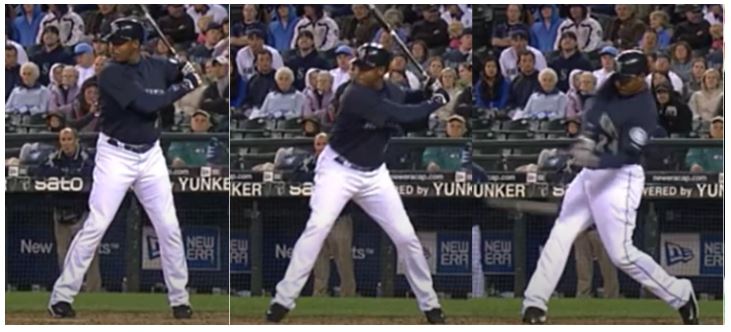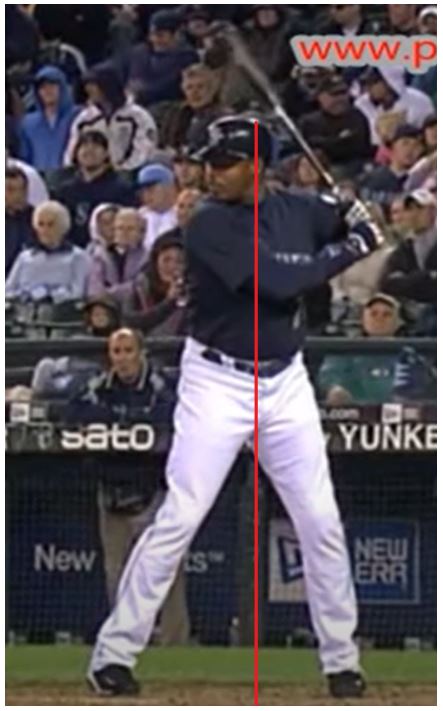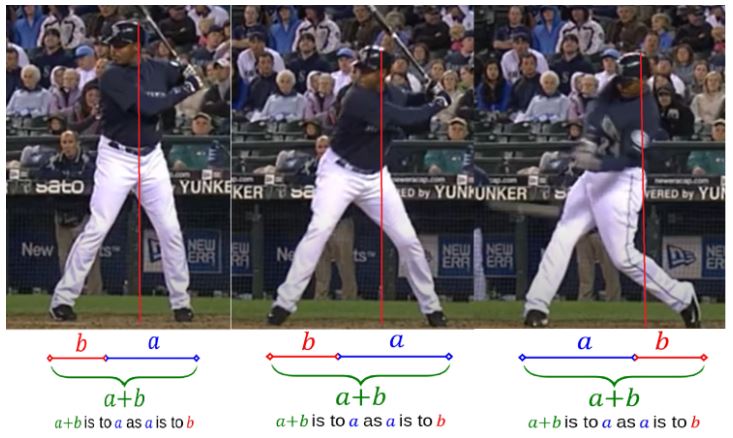
Ken Griffey jr., The Golden Ratio and The Perfect Batting Stance
By Ken Cherryhomes
Introduction to biomechanics and sacred geometry.
Baseball, at its core, is deeply rooted in biomechanics. Balance, force, and repeatability is critical for successful hitting. By analyzing the stance and swing of Ken Griffey Jr., a remarkable synchronicity emerges between his technique and the principles of the golden ratio, a mathematical constant prevalent in nature.
This analysis elucidates the connection between the technicalities of Griffey Jr.’s stance, the principles of biomechanics, and the inherent efficiencies associated with the golden ratio. By breaking down the components of his swing, we can draw parallels with this ancient numerical value, shedding light on the potential biomechanical advantages inherent in this alignment.
Ken Griffey Junior
These frames depict Ken Griffey jr., renowned for his beautiful swing and effortless power, in three stages of an at bat. In the first, he is in his “ready” position. His weight distribution can be assumed to be stored 55% back, 45% forward. His center of mass appears to be off center because of these weight distribution proportions.

If we imagine a line from the center of his head to the ground, we can delineate these proportions into two segments.

Ken is in a perfectly balanced position here, despite the appearance of asymmetry, his trunk (center of mass) being off center. The concept of balance in biomechanics in sports, doesn’t necessarily equate to perfect symmetry. Balance is about ensuring stability and control, particularly in dynamic situations like swinging a bat. The batter’s positioning allows him to leverage his body’s kinetic chain most efficiently.
While the trunk, which houses the majority of the body’s mass might appear off-center, it’s in a prime position to provide stability. The position of the CoM is critical for maintaining balance, especially as the batter prepares to swing and transfer weight.
His Base of Support, the distance between his feet provides a stable foundation. A broader base ensures greater stability, allowing the batter to shift more weight rapidly without losing balance.
As mentioned, the weight is distributed 55% back and 45% forward. This positioning primes the batter to generate power from the back leg (stored energy) and then transfer it efficiently through the swing, utilizing the forward leg as a pivot.
The stance also sets up the batter for optimal rotational energy. As the swing initiates, the energy stored in the back leg (55% segment) transfers through the hips and trunk, utilizing the torque generated by the rotation. The asymmetrical positioning aids in creating a more forceful and controlled swing.
The asymmetry in his stance is purposeful and strategic. It allows him to maintain balance, generate significant power, and maintain control throughout his swing. The understanding and application of these biomechanical principles are vital for maximizing hitting efficiency and power in baseball.

From here, we can examine Ken in three stages of an at bat. In the first, he is in his “ready” position. In the next frame, he is in his launch position. Finally in the third frame, he launched his swing and shifted his weight, roughly inverting those proportions from his ready position. We can observe his head in relation to his base of support remains in the same slightly off-center (back of center) position, no more or less, in each of these segments.
Below each frame is a depiction of the golden ratio, a way of observing Ken’s body positioning and weight distribution in two segments.
The golden ratio, often denoted by the Greek letter phi (Φ or φ), is an irrational mathematical constant approximately equal to 1.618. This number arises when a line is divided into two parts in such a way that the ratio of the whole line to the larger part is the same as the ratio of the larger part to the smaller part.
The golden ratio is found in many natural phenomena, from the spiral of galaxies to the structure of hurricanes. This could suggest that movements in line with the golden ratio are inherently efficient. In the context of a baseball swing, adhering to this proportion could mean a more effective transfer of energy and power, making the swing look ‘effortless.’ Movements that adhere to the golden ratio often look harmonious and natural. Griffey jr.’s swing might have been so pleasing to watch and so efficient and effective, precisely because of its alignment with this universal aesthetic as well as functionally efficient principle.
As seen from the consistent position of his head and trunk, Griffey jr. maintained a consistent and stable point of balance throughout his swing. By keeping the body’s center of mass within a base of support that aligns with the golden ratio, it offers an optimum balance point, allowing for both stability, mobility and fluid exchange of energy during the swing.
One of the keys to success in hitting is the repeatability of the swing. A swing that adheres to natural and mathematical principles will be easier to repeat consistently, leading to better adjustability of the swing without disrupting balance and performance.
